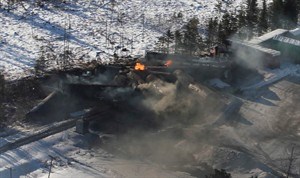
Derailed train cars burn in Plaster Rock, N.B., Jan.8, 2014. THE CANADIAN PRESS/Tom Bateman
January 13, 2014 - 2:13 PM
PLASTER ROCK, N.B. - The federal Transportation Safety Board said Monday it will conduct a full investigation into the cause of a CN freight train derailment in northwestern New Brunswick last week, with a specific focus on a cracked wheel.
Lead investigator Guy Laporte said he wants to know why the wheel on a car near the front of the train broke and went off the rail in the community of Wapske, near the village of Plaster Rock.
"If we find anything that's bad (with the wheel), we will make sure the industry will know about that and all of the railway companies," Laporte said in an interview.
Laporte said a single broken wheel can rapidly knock an entire train off the tracks.
"A broken wheel could break a rail, or break a switch or break any component on the track," he said.
He said it's too early to say whether there is a wider problem with the manufacturing or maintenance of the wheel or whether it was an isolated incident.
There were 60 cars between the wheel and the pileup of derailed tanker cars, he said. In all, 19 cars and a locomotive on the 122-car train left the tracks last Tuesday, spilling diesel and oil and causing a fire that lasted for days. About 150 people had to be evacuated from their homes.
The DOT-111 tank cars involved in the derailment are considered the workhorses of the North American rail fleet and make up about 70 per cent of all tankers on the rails.
CN (TSX:CNR) spokesman Jim Feeny said the construction of DOT-111 cars is a broad issue confronting the railway industry.
"Our CEO has called for a phase-out of these (cars), but it's an industry-wide issue, not just a CN issue," he said.
Laporte said the two cars that were punctured didn't have head shields, which are heavy steel plates at the ends of tanker cars designed to reduce the chance of punctures.
"We are looking to find ... if a shield had been in front, would the tank have been more protected?" he said.
The federal government proposed new regulations on Friday that would require rail tank cars that carry crude oil and other dangerous goods to be built stronger and less likely to rupture in a derailment. The proposals would include the use of head shields.
Makers of the cars are already building them to the soon-to-be-implemented standards.
As the Transportation Safety Board's investigation gets underway, the New Brunswick government and CN Rail are cleaning up the pollution from the derailment.
Richard Keeley, a regional director with the province's Environment Department, said 50 wells are being tested for pollution and results will be reported by the Health Department beginning Tuesday. In the meantime, residents are being told not to drink their water.
Keeley said two people whose house is within 100 metres of the derailment were still unable to return home Monday due to the cleanup. He estimated it will be two weeks before soil remediation at the site is completed.
Dump trucks have been hauling away soil contaminated with diesel fuel and heavy and light crude oil, Keeley said.
There was also pollution from a propane car that was blown up in a controlled explosion, he added.
— By Michael Tutton in Halifax.
News from © The Canadian Press, 2014